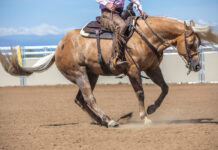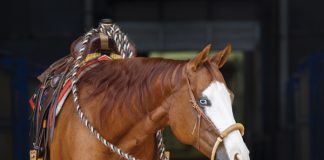
Horses trained to demonstrate the good manners, responsiveness and smooth movement that characterize the consummate ranch horse are putting their skills to the test in the recently introduced ranch pleasure class. Debuted in 2012 by the American Quarter Horse Association (AQHA), it has since grown dramatically in popularity. Highlighting the handiness of the typical working American Quarter Horse, ranch pleasure is all about a free-moving, ground-covering mount that can get a job done and do it well.
Ross believes the broad appeal of the class is due to the fact that people appreciate a horse that moves freely and naturally, has a lot of expression, and shows ability at all gaits and in various maneuvers.
“This is a class that requires a versatile horse that is well-trained but not overly structured,” adds Ross. “He must be a very all-around horse, plus a good mover. It’s not as easy as some people think.”
The Appeal of Ranch Pleasure
The practical aspect of ranch pleasure appeals to riders who might otherwise not enter a breed show. For example, Emily Peak of Stapleton, Ala., only started showing at AQHA events in 2013, and it was wholly because of this particular class.
“When ranch pleasure was offered, I was all over it because that’s my kind of horse,” says Peak, who has since begun competing in reining and horsemanship classes on her 2004 AQHA gelding, Islehava Mocha Latte, affectionately known as “the Roanie Pony.”
“Ranch pleasure is a place to show a great using horse with forward-moving gaits and handiness,” explains Peak. “It allows you to get your horse more well-rounded and broke. It’s really a transition class. There are a lot of horses that might be able to stop, are handy and have good turn-arounds but don’t have the transitions. Patterns keep horses sharp; they have to use themselves correctly. The more broke they get, the more you see that.”
Although 2013 was Peak’s rookie year in the AQHA, she and her Roanie Pony did well enough to qualify for the world show, and even made it to the finals. Out of 79 horses in the amateur ranch pleasure class, they finished 15th.
“I think what makes ranch pleasure appealing to a lot of amateurs and novice amateurs is that you don’t really need a trainer, although it helps,” notes Peak, who worked with a trainer to educate her green-broke horse in reining, trail and cow work. “It’s not as intimidating because you don’t have to have the fancy clothes and saddle. It’s just about the best horse doing what he’s meant to do and doing it well.”

What Makes a Ranch Pleasure Horse?
Mozaun McKibben of Whitesboro, Texas, a longtime horseman and clinician and winner of world championships in ranch pleasure at both the 2012 and 2013 AQHA World Championship Shows, appreciates the fact that this class rewards the versatility of an all-around ranch-bred Quarter Horse.
“A horse that moves like a western pleasure horse isn’t going to do well in this class,” says McKibben. “A horse bred to move that way just doesn’t have real forward movement. When you’re on a ranch, you want a horse to get across the country, not go slow.
“I think the main reason people like it is because it’s about the natural movement of the horse,” adds McKibben, who was raised on a ranch in New Mexico and is very familiar with good working horses.
How to Win Ranch Pleasure
To score well in ranch pleasure, a horse must be good at transitions. For example, horses may be required to transition from an extended lope down to a walk, which is challenging for even the most well-schooled mount. McKibben says a rider must give the horse unmistakably clear cues for each transition.
Although there are several different patterns for ranch pleasure, each requires the walk, jog, extended jog, lope and extended lope, along with three of five optional maneuvers and a change of direction. Judges are looking for cadence and rhythm in each gait, smoothness, consistency and well-executed maneuvers.
In ranch pleasure, riders can either post the trot or stand in the stirrups with one hand on the horn for balance. McKibben prefers to stand and feels it gives his horse a more direct signal.
“My horse knows when I’m standing in the stirrups that he needs to reach out, extend his trot and relax into it,” explains McKibben. “When my butt hits the saddle, he knows it’s time to make a transition and that we’re either going to slow down or speed up.”
The Future of AQHA Ranch Pleasure
When ranch pleasure debuted in 2012, it was only in the open division. In 2013, youth, amateur and select amateur divisions were offered. As of Jan. 1, 2014, AQHA show management is offering junior and senior ranch pleasure for the open division, as well as Level 1 (formerly known as novice) for youth and amateurs.
For more information about ranch pleasure, visit www.aqha.com.
This article originally appeared in the June 2014 issue of Horse Illustrated magazine. Click here to subscribe!






Is this Strickland for AQHA? I have a registered Missouri Fox Trotter that would do very well in this class.